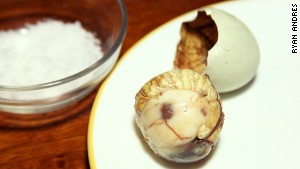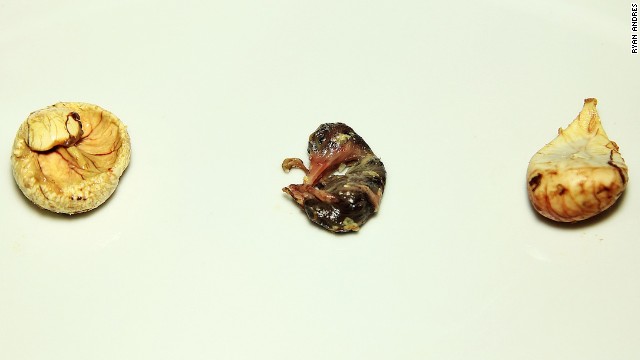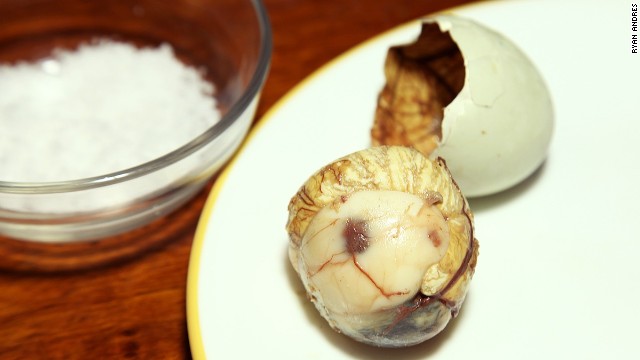Balut: The Filipino delicacy that makes the world squirm
February 6, 2014
STORY HIGHLIGHTS
- Balut, an 18-day-old fertilized duck egg, is a popular snack in the Philippines
- Acceptance of balut depends on exposure at a young age
- First time eaters are advised to not dwell on the textures
The 18-day-old fertilized duck
egg -- a snack widely eaten in the Philippines -- has revolted even
the most daring foodies with its carnal textures, earning it lofty rankings on
many a "most disgusting/strange/terrifying food" list.
While food journalists commonly
label balut as the Philippines' "much loved delicacy," in reality Filipinos are
decidedly split over their nation's oft-sung snack.
The science experiment
you eat
Acceptance of balut often depends
on exposure at a young age, much like Vegemite in Australia.
In an apparent attempt to
preserve the delicacy's popularity among the country's rapidly modernizing and
discriminating palates, some schools in the Philippines introduce balut to young
students during science classes.
Students use balut to study the
anatomy of birds, then eat the compressed bird beak, veins and developing wings
within.
"Our teacher made us eat the egg
so it wouldn't go to waste," says Manila resident Anna Vecin of her ordeal.
"And if we didn't eat it, we'd
get a low score on that day's lesson. Of course, I had no choice but to eat
it."
The experience can leave some
with a lifelong aversion to the so-called national delicacy.
Even balut's tamer cousin, penoy
-- an unfertilized duck egg billed as a less carnal option, given that it lacks
the semi-developed chick within -- can be hard to stomach.

The yolk is easily detached from the shell, veins and all.
Taste over
appearance
For others, balut's combination
of savory soup, fresh meaty bird and warm yolk is a revelation.
"My dad had a duck farm once
upon a time in Binangonan, Rizal, so at some point growing up, we had a lot of
them at home," recalls Cheryl Tiu, a Manila-based writer.
"My mom's parents always enjoyed
eating it, thus it got passed on to her and her siblings, and then down to us.
My favorite part is the soup. And then I dip the yolk in rock salt.
"Today though, I'm not sure if I
can eat the whole chick anymore, unlike when I was much younger."
The dish is particularly popular
among Filipino families with ethnic Chinese backgrounds.
Balut is also widely enjoyed
across numerous provinces in China, especially in the south.
Like many Chinese dishes, balut
comes with a list of putative health benefits.
Among these, it's claimed balut
can boost male fertility and libido.
Balut in New
York
Can't make it to Manila?
Though balut is hard to find
outside the Philippines, New York Filipino restaurant Maharlika offers the delicacy
for $5 a pop.
The restaurant hosts an annual
balut eating contest, held every August.
Last year's winner knocked
back 27 balut in five minutes.
Think you can do better?
 The
semi-formed bird fetus (pictured) slides right out of the shell. You can eat it
by taking a "shot" of the contents, dipping your head back to let the bird slide
into your mouth. Some prefer to dip it in a dash of salt or vinegar before
eating.
The
semi-formed bird fetus (pictured) slides right out of the shell. You can eat it
by taking a "shot" of the contents, dipping your head back to let the bird slide
into your mouth. Some prefer to dip it in a dash of salt or vinegar before
eating.
 The only
thing left is the yolk. It can be scooped out with a spoon, but many Filipinos
prefer to use their fingers. It's easily detached from the shell, veins and all.
Some prefer to reverse these steps -- cracking the wider end of the shell to eat
the yoke first -- saving the little duckling for last.
The only
thing left is the yolk. It can be scooped out with a spoon, but many Filipinos
prefer to use their fingers. It's easily detached from the shell, veins and all.
Some prefer to reverse these steps -- cracking the wider end of the shell to eat
the yoke first -- saving the little duckling for last.
No comments:
Post a Comment